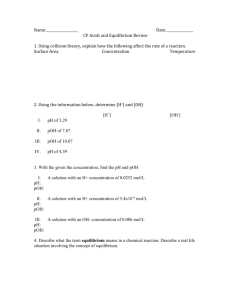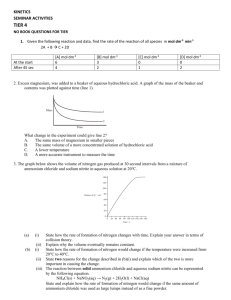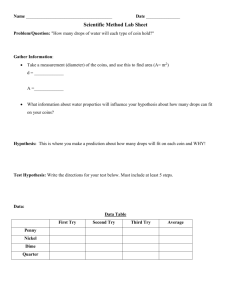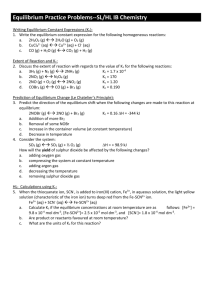Word File
advertisement
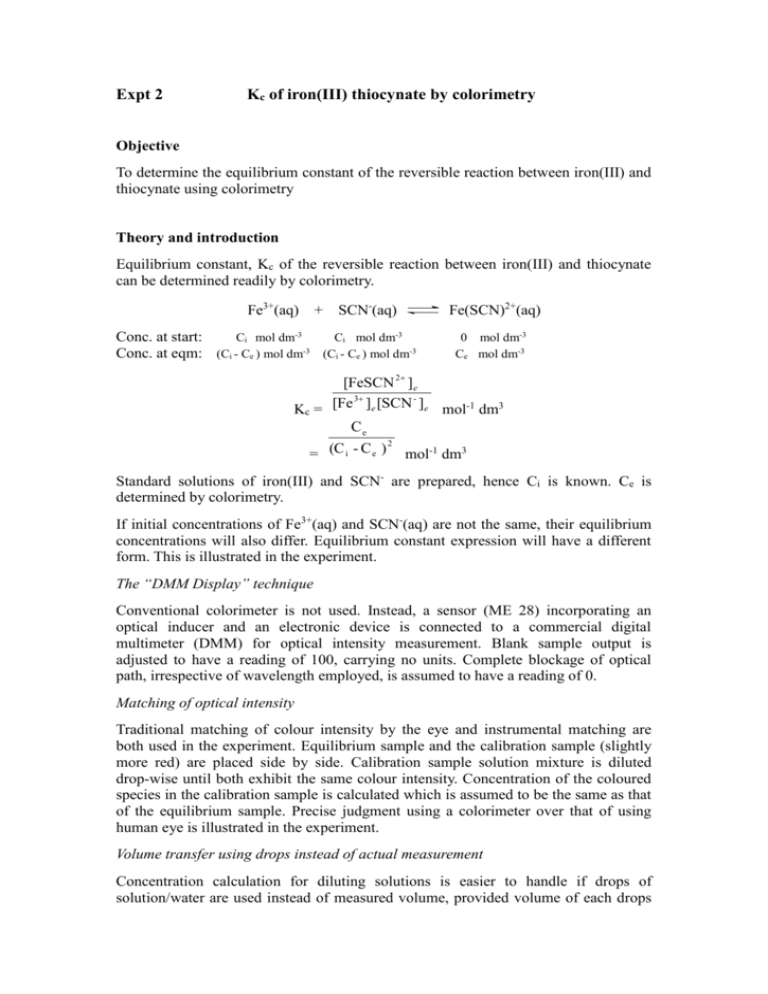
Expt 2 Kc of iron(III) thiocynate by colorimetry Objective To determine the equilibrium constant of the reversible reaction between iron(III) and thiocynate using colorimetry Theory and introduction Equilibrium constant, Kc of the reversible reaction between iron(III) and thiocynate can be determined readily by colorimetry. Fe3+(aq) + SCN-(aq) Conc. at start: Ci mol dm-3 Ci mol dm-3 -3 Conc. at eqm: (Ci - Ce ) mol dm (Ci - Ce ) mol dm-3 Fe(SCN)2+(aq) 0 mol dm-3 Ce mol dm-3 [FeSCN 2 ]e 3 Kc = [Fe ]e [SCN ]e mol-1 dm3 Ce 2 = (C i - C e ) mol-1 dm3 Standard solutions of iron(III) and SCN- are prepared, hence Ci is known. Ce is determined by colorimetry. If initial concentrations of Fe3+(aq) and SCN-(aq) are not the same, their equilibrium concentrations will also differ. Equilibrium constant expression will have a different form. This is illustrated in the experiment. The “DMM Display” technique Conventional colorimeter is not used. Instead, a sensor (ME 28) incorporating an optical inducer and an electronic device is connected to a commercial digital multimeter (DMM) for optical intensity measurement. Blank sample output is adjusted to have a reading of 100, carrying no units. Complete blockage of optical path, irrespective of wavelength employed, is assumed to have a reading of 0. Matching of optical intensity Traditional matching of colour intensity by the eye and instrumental matching are both used in the experiment. Equilibrium sample and the calibration sample (slightly more red) are placed side by side. Calibration sample solution mixture is diluted drop-wise until both exhibit the same colour intensity. Concentration of the coloured species in the calibration sample is calculated which is assumed to be the same as that of the equilibrium sample. Precise judgment using a colorimeter over that of using human eye is illustrated in the experiment. Volume transfer using drops instead of actual measurement Concentration calculation for diluting solutions is easier to handle if drops of solution/water are used instead of measured volume, provided volume of each drops Expt 2 Kc of iron(III) thiocynate Page 2 are the same. Concentration of diluted solution No. of drops of water added = Original concentration x No. of drops of solution no. of drops of water added Note: * For the concentration calibration part of the experiment, large excess of iron(III) over thiocynate should be used * Time is required to attain chemical equilibrium, especially for situations involving dilution of the iron(III) complex ion. Wear safety spectacles and avoid skin contact with the chemicals. Use the minimum quantity of materials required. Dispose of chemical waste and excess materials according to your teacher’s instruction. EYE PROTECTION MUST BE WORN Materials and Apparatus Chemicals and consumables Qty Equipment Qty 0.2M Fe(NO3)3 10 cm3 Colorimeter ME 28 with connector 1 0.02M Fe(NO3)3 20 cm3 Digital multimeter 1 0.02 M KSCN 20 cm3 Disposable cuvette (12.5 x 12.5 x 45 mm) 3 Plastic dropper (large) 4 100 cm3 beaker 1 Wash bottle with distilled water 1 Tweezers 1 Experimental procedures Expt (A) Set full-scale (i.e. 100 mV) 1. Connect ME 28 to a DMM and select the DC 200 mV range 2. Switch on ME 28 and select the 470 nm (blue) light source 3. Fill a clean cuvette 3/4 full with distilled water 4. Lower the cuvette with the help of a pair of tweezers into the sample tube cavity, ensuring the clear sides of the tube are used for the optical experiment. Expt 2 Kc of iron(III) thiocynate Page 3 5. Turn the knob until a display of 100.0 (or very close to) is shown 6. Fix the position of the knob. The setup is ready for experiment. (i) Equilibrium sample reading 1. Transfer, with the help of a plastic pipette, 5 drops of 0.02M Fe(NO3)3 to a clean cuvette, followed by 5 drops of 0.02M KSCN. Add 40 drops of distilled water to make the final volume equal to 50 drops of red equilibrium mixture solution. Allow 5 mins for chemical equilibrium. 2. Place the prepared solution mixture into the sample cavity, with cuvette’s clear sides facing the light source. Record the voltage registered. Take it out from the cavity. (ii) Calibration sample reading 1. Add 10 drops of 0.02M Fe(NO3)3 to another clean cuvette followed by 1 drop of 0.02M KSCN. Place it sided by side with the earlier cuvette. Add drops of distilled water until it appears to have the same colour intensity as the equilibrium sample. 2. Lower the calibration sample cuvette into the sensor cavity. Note the voltage reading displayed. It should be less than that of the equilibrium sample reading. This means the calibration sample is darker than the equilibrium sample. This otherwise cannot be detected by our eye. 3. Continue to add drops of distilled water until the DMM reading is exactly the same (or close to) as the equilibrium sample. Allow10 mins for chemical equilibrium. Record the total number of drops of distilled water added. Expt (B) Repeat Expt (A) Part (i) becomes 4 drops of 0.02M Fe3+(aq) added to 6 drops of SCN-(aq) followed by 40 drops of distilled water Part (ii) remains the same. Expt (C) Repeat Expt (A) Part (i) becomes 6 drops of 0.02M Fe3+(aq) added to 4 drops of SCN-(aq) followed by 40 drops of distilled water Part (ii) remains the same. Expt 2 Kc of iron(III) thiocynate Page 4 Results Colour of LED: blue Solution temperature: 29oC Equilibrium Calibration Number of drops Expt. Number of drops .02M KSCN 0.02M Fe(NO3)3 Distilled water A 5 5 40 B 4 6 C 6 4 DMM reading DMM reading 0.02M KSCN 0.2M Fe(NO3)3 Distilled water 24.5 1 10 52 24.8 40 25.0 1 10 54 24.9 40 34.4 1 10 60 34.5 Calculations (consider data obtained in Expt A) (1) Calibration sample Since presence of Fe3+(aq) is in large excess over that of SCN-(aq), It is assumed that all of the SCN-(aq) ions are converted to the deep red complex ion Fe(SCN)2+(aq). Hence concentration of the adjusted Fe(SCN)2+(aq), is the same as 1 that of the equilibrium sample, i.e. Ce = 0.02 x (1 10 53) M =3.175 x 10-4 M (2) Equilibrium sample Initial concentration of Fe3+(aq), Ci = Initial concentration of SCN-(aq) = 0.02M x 5 (5 5 40) = 0.002M Fe3+(aq) + At start: 0.002 mol dm-3 SCN-(aq) Fe(SCN)2+(aq) 0.002 mol dm-3 0 mol dm-3 At eqm: (0.002 - 3.175 x 10-4) mol dm-3 (0.002 - 3.175 x 10-4) mol dm-3 3.175 x 10-4 M mol dm-3 [FeSCN 2 ]e 3 Kc = [Fe ]e [SCN ]e mol-1 dm3 3.175 x 10 -4 -4 2 = (0.002 - 3.175 x 10 ) mol-1 dm3 = 113 mol-1 dm3 No standard literature value for the Kc of iron(III) thiocynate. Acceptable range: 90-120 mol-1 dm3 Expt 2 Kc of iron(III) thiocynate Page 5 [FeSCN 2 ]e [Fe 3 ]e [SCN - ]e [Fe3+(aq)]eqm [SCN-(aq)]eqm [Fe(SCN)2+(aq)]eqm -3 /mol dm -3 /mol dm -3 /mol dm 1 0.00168 0.00168 3.175 x 10-4 113 mol-1dm3 2 0.00129 0.00209 3.077 x 10-4 114 mol-1dm3 3 0.00212 0.00132 2.817 x 10-4 101 mol-1dm3 Expt. Questions for discussion (1) Why is it necessary to use a large excess of Fe3+(aq) in making the calibration sample solution? __________________________________________________________________ __________________________________________________________________ To shift the equilibrium position far to the right so that practically all the SCNions are converted to the Fe(SCN)2+ complex ion. (2) Why use the blue LED light source? Can we use another source of light, like the green or red LED? __________________________________________________________________ __________________________________________________________________ Monochromatic blue wavelength is best absorbed by the deep red Fe(SCN)2+ solution. Green monochromatic light is also workable, but less good. Not recommended to use red monochromatic light. (3) Briefly explain whether or not you would average the three experimental Kc values to obtain a concluding result. __________________________________________________________________ __________________________________________________________________ __________________________________________________________________ __________________________________________________________________ For finer details of concentration consideration, we should not just consider the calculated molarity, but the effective concentration instead. Effective concentration is the portion of ions in the environment of random distribution of positive and negative aqueous ions that are responsible for chemical reaction. Effective concentration is expressed in activity Activity of the SCN (aq) ion and that of the Fe3+(aq) ion do not vary in the same way with the amount of water added, We should consider separately the three experimental Kc values. However, when students are not taught about the concept of activity, averaging collected results is a correct way. Expt 2 Kc of iron(III) thiocynate Page 6 (4) List (i) one major source of experimental error and (ii) one major theoretical error for the experiment.. __________________________________________________________________ __________________________________________________________________ __________________________________________________________________ __________________________________________________________________ (i) (ii) Inaccuracy in volume of solutions delivered Activity should be used instead of molarity Conclusion _____________________________________________________________________ _____________________________________________________________________


